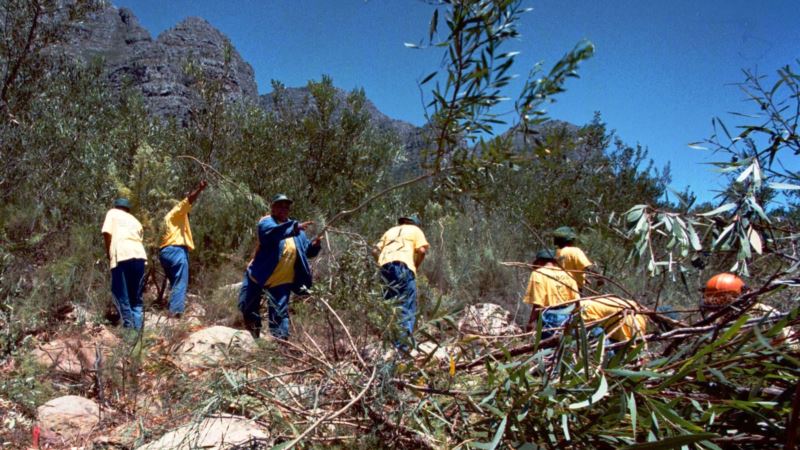Cape Town is planning to launch a new fund by the end of 2017 that will improve its water supply by restoring the native shrubland plants covering the region's watersheds and aquifers. Amid uncertain rainfall patterns as the planet warms, protecting indigenous vegetation should yield more water for the city's consumption, said Colin Apse, director for freshwater conservation in Africa at the Nature Conservancy, a U.S.-based nonprofit group that is working with Cape Town on the fund. "Depending on the green infrastructure investments chosen, a Cape Town Water Fund could lead to a range of climate change adaptation benefits," Apse said. In recent years, scientists have researched the impact of alien plant invasions in watersheds and riverbank areas in South Africa. In 2014, experts with the Council for Scientific and Industrial Research found that restoration of Cape Town's native "fine bush" (fynbos) and removal of invasive "water thirsty" plants had cut water consumption by vegetation and increased rainwater recharge. South Africa started a "Working for Water" program in 1995 that has helped control invasive plants, as well as alleviating poverty through employment in clearing unwanted vegetation. Alien invasion Yet despite government investment of more than 3 billion rand ($211 million) in clearing some 2 million hectares (4.94 million acres) in the first 15 years, South Africa's watersheds are still heavily invaded by alien plant species, said Louise Stafford, Cape Town's green jobs program manager. Nineteen million hectares are estimated to be affected across the country, she added. The money raised through the new water fund will be used to step up existing efforts, she said. Councillor Johan van der Merwe said the fund would pay for conservation efforts in the west coast area of Cape Town. The fund's value has yet to be fixed, but the money will come from different sources, including public spending, foundations, international donors such as the Global Environment Facility, and water and power utilities, he added. The Cape Town metropolitan area covers 2,445 square kilometers and has a population of about 3.8 million people, growing at a rate of almost 3 percent a year. Ensuring an adequate supply of water during recurring droughts is critical if the city is to develop in a sustainable fashion and safeguard economic growth, experts say. Cape Town's 14 reservoirs and two aquifers — the largest being Atlantis Aquifer — will need to be managed better, said Van der Merwe. The Atlantis Aquifer protection zone will likely be the first focus of the fund, he added. Recharge of that aquifer has been reduced by the dense alien plant infestation on its surface, Stafford said. "Invasive plants use more water than indigenous plants due to their deep root systems which can travel further and absorb more water, [and] their larger leaf surface area also increases evapotranspiration," she said. Help for surrounding towns The fund's investments, while improving water security and ecosystem functions, may also boost the impoverished surrounding towns of Atlantis, Mamre and Pella, through jobs in controlling invasive plants and restoring fynbos, Van der Merwe said. More could come indirectly from tourism as people will be attracted to view flowers farther up the west coast, he added. The Nature Conservancy's Apse said Latin America is leading the way in developing water funds. From Quito to Sao Paulo, Latin American cities are investing in watershed conservation. This has led to cleaner water supplies by cutting pollution and reducing upstream erosion and reservoir sedimentation, he said. Cape Town could see similar benefits, he added. A study on urban water in sub-Saharan Africa, released by the Nature Conservancy in July, said 28 cities could improve water supplies for more than 80 million residents by investing in conservation, including forest protection and good farming practices on land that drains into rivers, lakes and aquifers. In Cape Town, better water quality could offset the costs of conservation due to lower spending on water treatment and desalination, providing a "dramatic return on investment," the report said. In 2015, the Nature Conservancy, which is involved in 60 water funds globally, helped set one up in Kenya. It is maintaining hydropower production capacity on the Tana River, which accounts for around half of Kenya's hydroelectricity. The river supplies 95 percent of the water for Nairobi's 4 million residents. Sediment in reservoirs is being reduced through measures such as agricultural terracing and new plantings paid for by the Upper Tana-Nairobi Water Fund, Apse said. When reservoirs have high levels of sediment, they have to be dredged, interrupting power production and incurring a cost. But even a modest rise in the water collected increases power generation along the hydropower dam cascade on the Tana River downstream of the water fund projects, Apse said. Not much rain Mike Lucas, a biologist at the University of Cape Town, said South Africa is a water-stressed country with average annual rainfall of less than 400 millimeters (15.75 inches) per year. That has to service high demand from domestic use, agriculture and industry. In the Western Cape, climate models predict the average amount of rainfall will decrease, with less occurring in winter and slightly more in the summer — but with an overall net loss. "Our precious water reserves will need to be conserved and recycled, particularly in the face of a growing population that rightly demands proper services, including potable water," Lucas said. Changing rainfall will also affect plants and biodiversity, with fynbos — which prefers hot, dry summers — pressured by the invasion of alien grasses competing for a declining amount of water. Clearing invasive vegetation could help cut water use, particularly where replaced by indigenous plants, but not if crop cultivation is seen as a viable alternative on that land. "This may result in more water being used than is saved," Lucas warned.
Water Fund to Slake Cape Town’s Thirst by Restoring Native Plants






